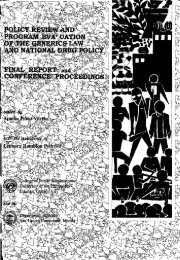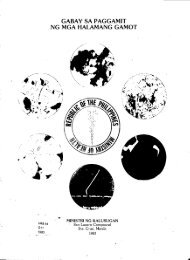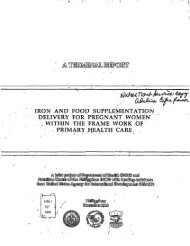ON FOOD fORTI - DOH Central Library - Department of Health
ON FOOD fORTI - DOH Central Library - Department of Health
ON FOOD fORTI - DOH Central Library - Department of Health
You also want an ePaper? Increase the reach of your titles
YUMPU automatically turns print PDFs into web optimized ePapers that Google loves.
28<br />
A Report on Food Fortification<br />
IODINE AND IR<strong>ON</strong> FORTIFIED FISH SAUCE<br />
AND OTHER C<strong>ON</strong>DIMENTS<br />
Mr. HECTOR MAGLALANG<br />
Fortification Consultant, Nutrition 'Service-<strong>Department</strong> <strong>of</strong> <strong>Health</strong><br />
Condiments are food substances<br />
added to basic foodstuff to enhance the<br />
flavor <strong>of</strong> food. It is also called flavoring<br />
agents, seasonings, or spices. Condiments<br />
are widely consumed food products in<br />
the Philippines. Studies by the University<br />
<strong>of</strong> the Philippines have cited salt and<br />
monosodium glutamate (MSG) as some<br />
<strong>of</strong> the most fortifiable foods but for this<br />
discussion, I would like to concentrate<br />
on the fortification <strong>of</strong> fish sauce, salt and<br />
soy saucewithbothiron and iodine. Other<br />
condiments that can be considered are<br />
ketchup and MSG.<br />
.-<br />
.First, the fortification <strong>of</strong> fish sauce.<br />
This is a clean, lightbrownliquid prepared<br />
by fermentation and extraction <strong>of</strong> marine<br />
fish and used as a flavoring or salt<br />
substitute. This is ideal for fortification<br />
because the production <strong>of</strong> fish sauce is<br />
concentrated in and around Malabon and<br />
Navotas in Metro Manila, and this<br />
concentration <strong>of</strong> production is one <strong>of</strong> the<br />
requirements for a food product to be<br />
considered for fortification.<br />
Studies in iron fortification <strong>of</strong> soy<br />
sauce were inititated in Thailand around<br />
1974 because the Thais are also fond <strong>of</strong><br />
using fish sauce. From their experiments<br />
they haveconcluded thatethelenediamine<br />
tetraacctic acid sodium iron EDTA is the<br />
most suitable fortificant for iron in fish<br />
sauce than all the other iron sources,<br />
because no precipitation was observed<br />
in fish sauce. In other iron sources,<br />
precipitation takes place aftertwoor more<br />
hours but for the sodium iron EDTA no<br />
precipitation was observed even for<br />
mon!hs. After determining the most<br />
suitable fortificant in terms <strong>of</strong> the<br />
difference in the physical properties' <strong>of</strong><br />
the food, they tested it for taste using<br />
a double blind technique. There was no<br />
effect on the taste <strong>of</strong> variousfood products<br />
where sodium iron EDTA fortified fish<br />
sauce was used as the condiment.<br />
On the bioavailability <strong>of</strong> iron, 7-8%<br />
is absorbed in combination with other<br />
foods On the average, which is usually








